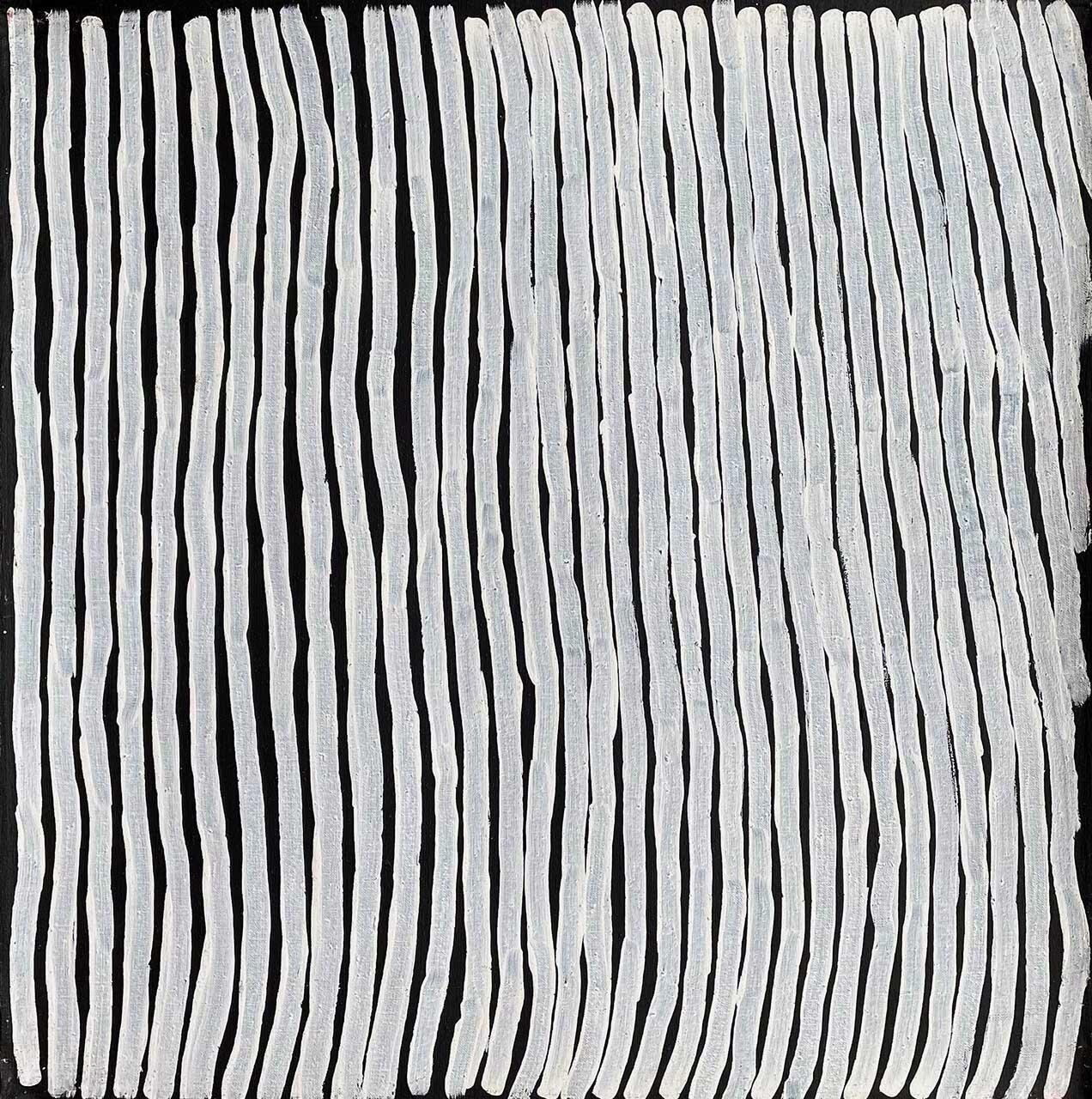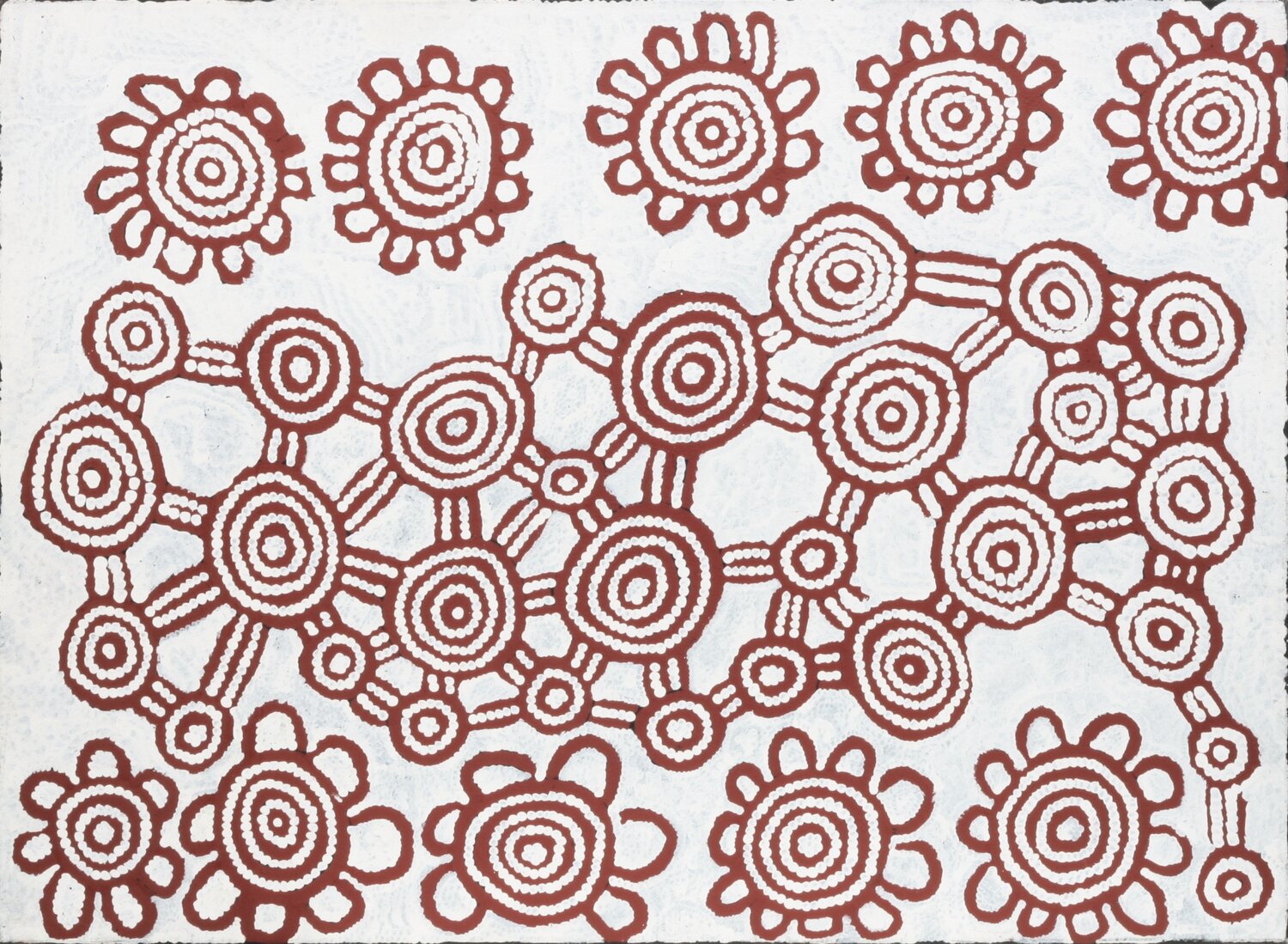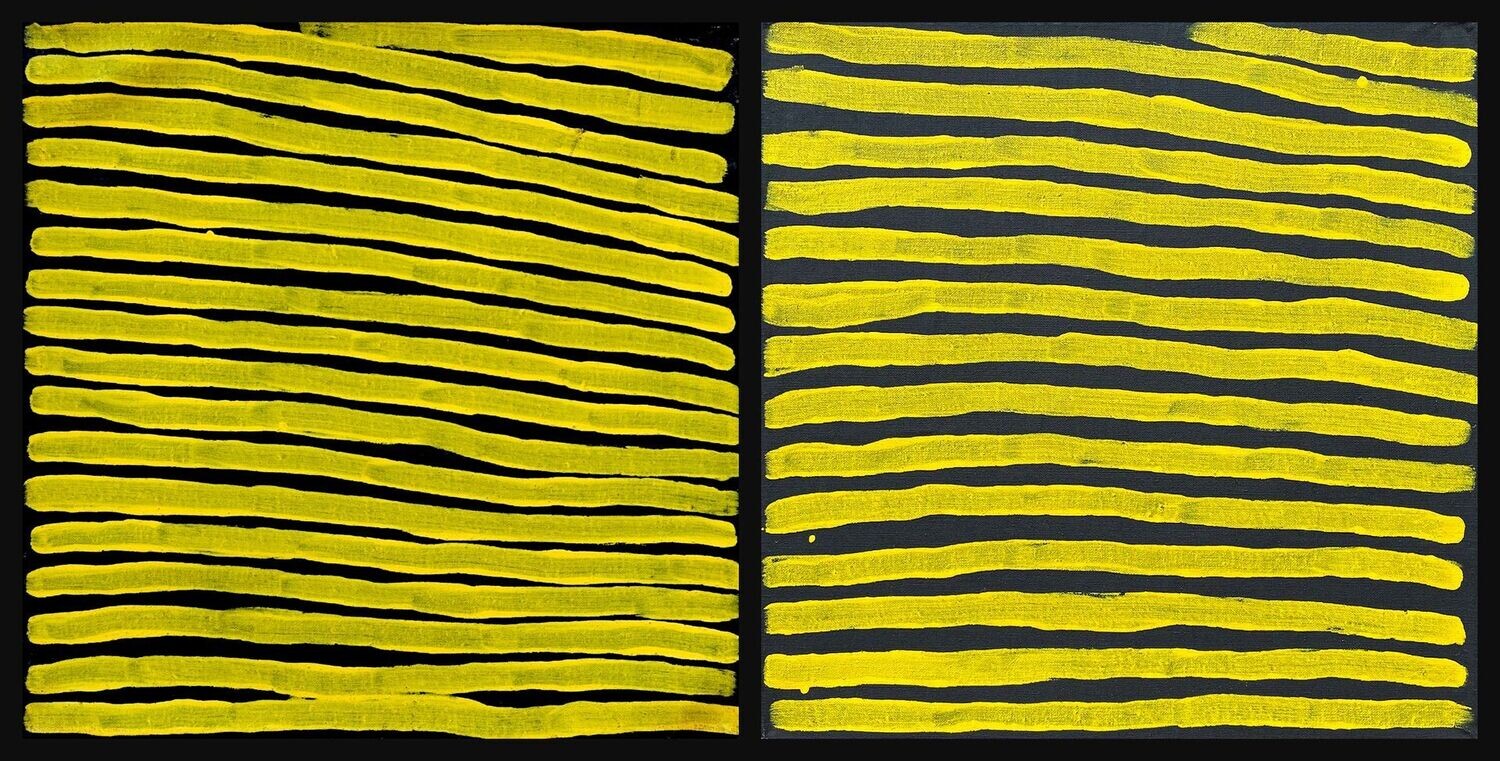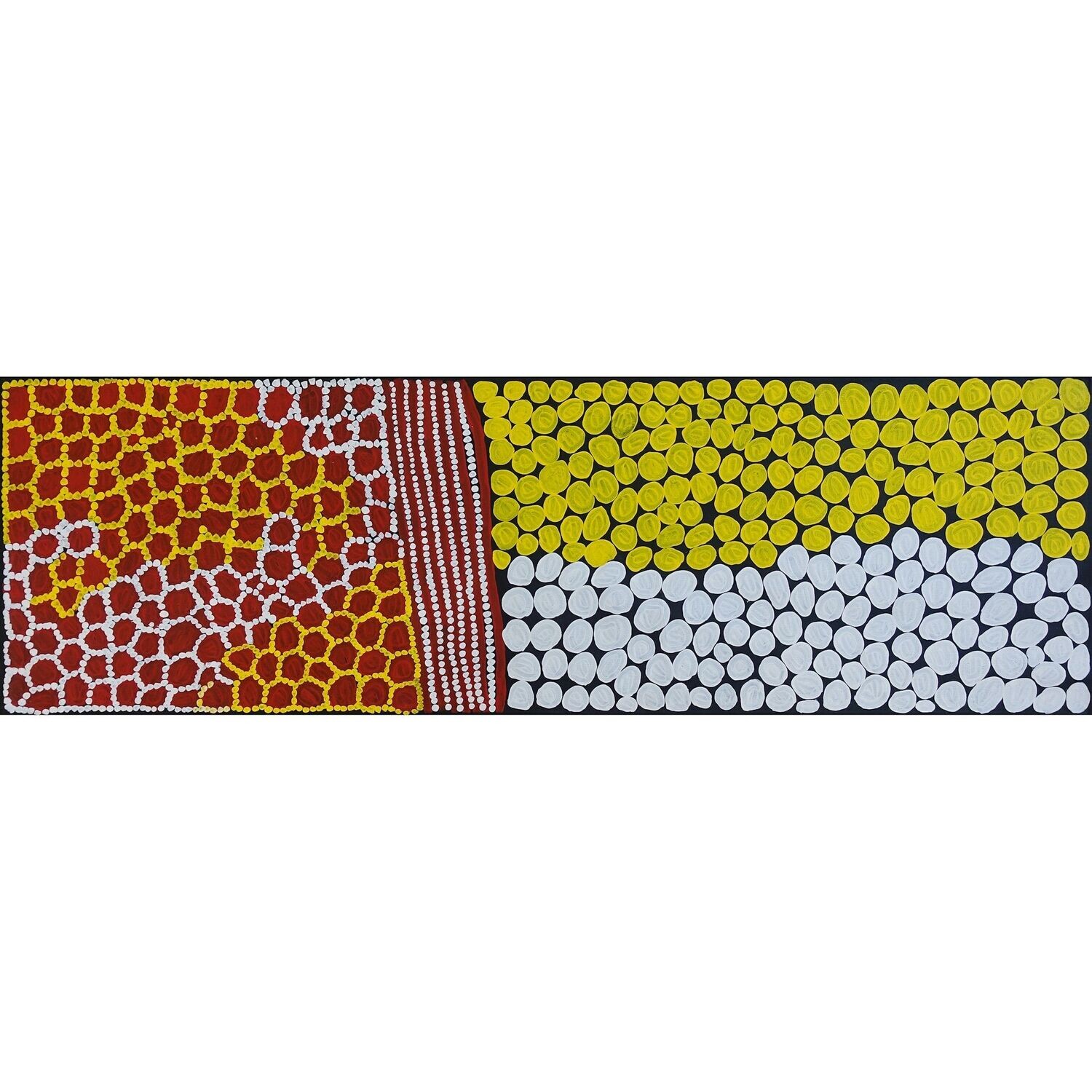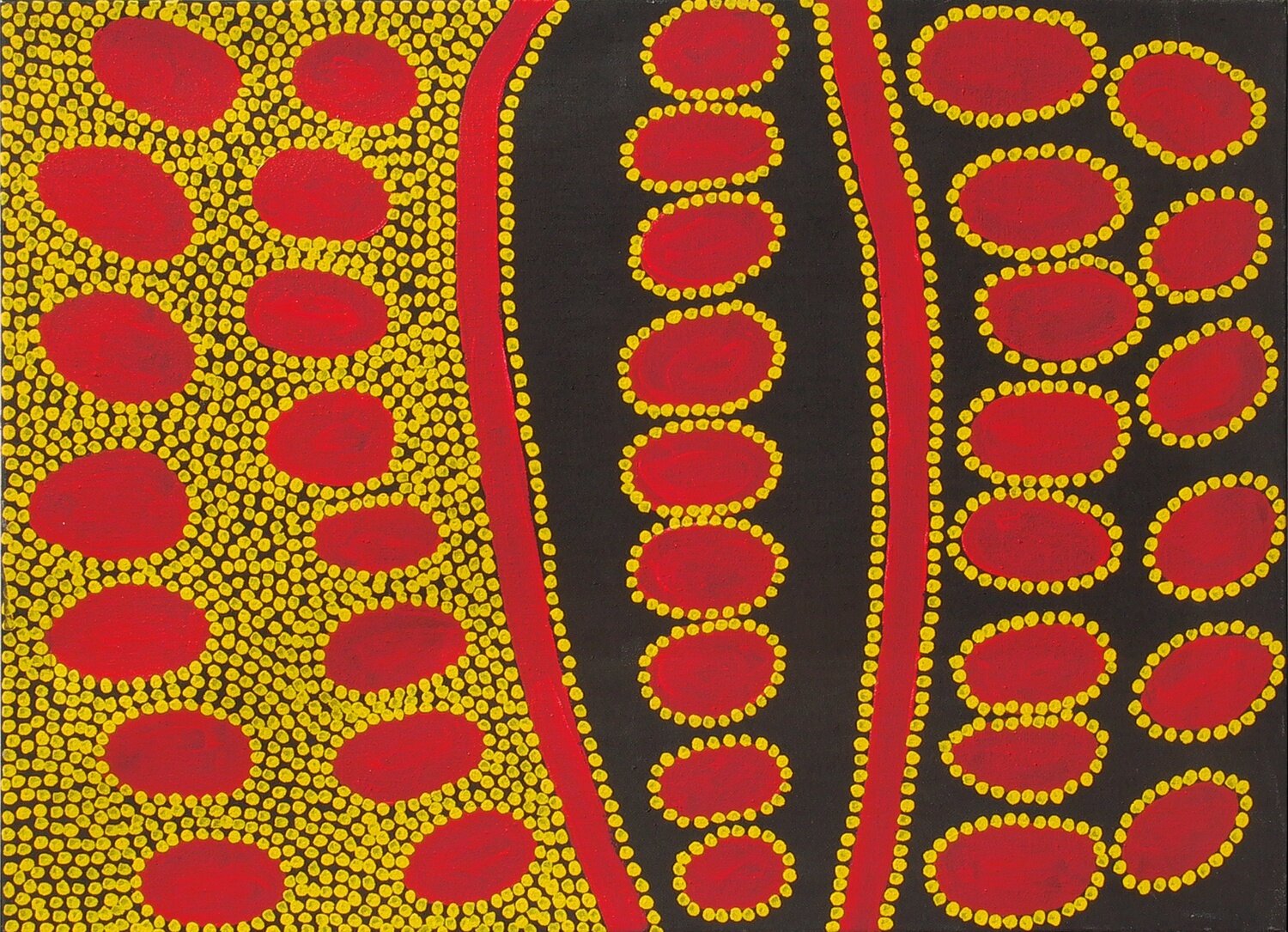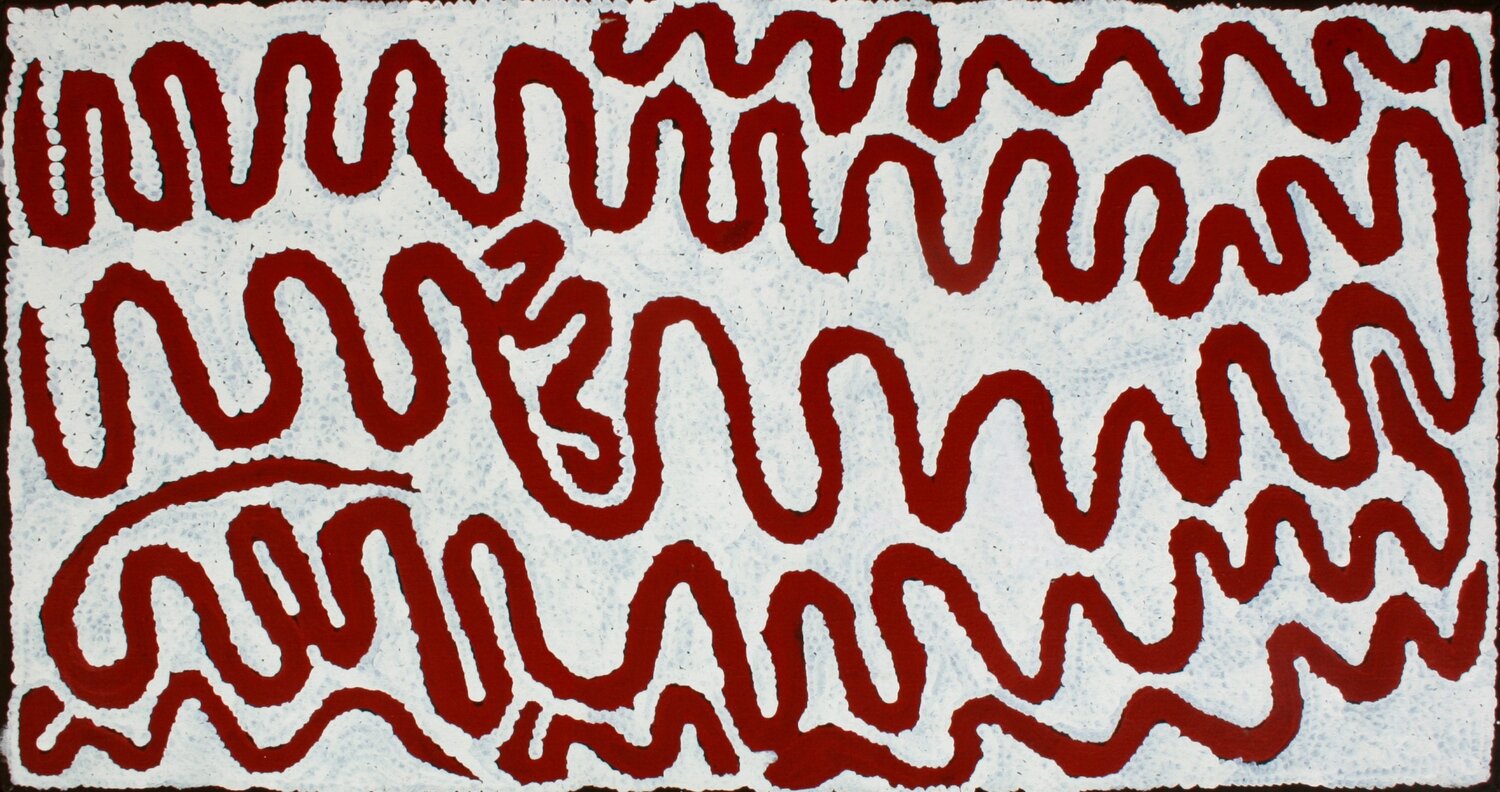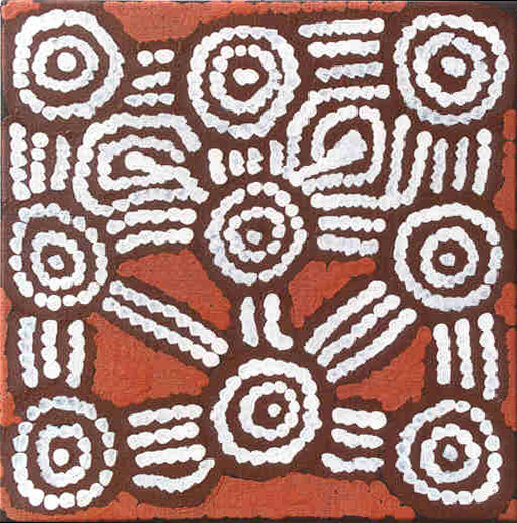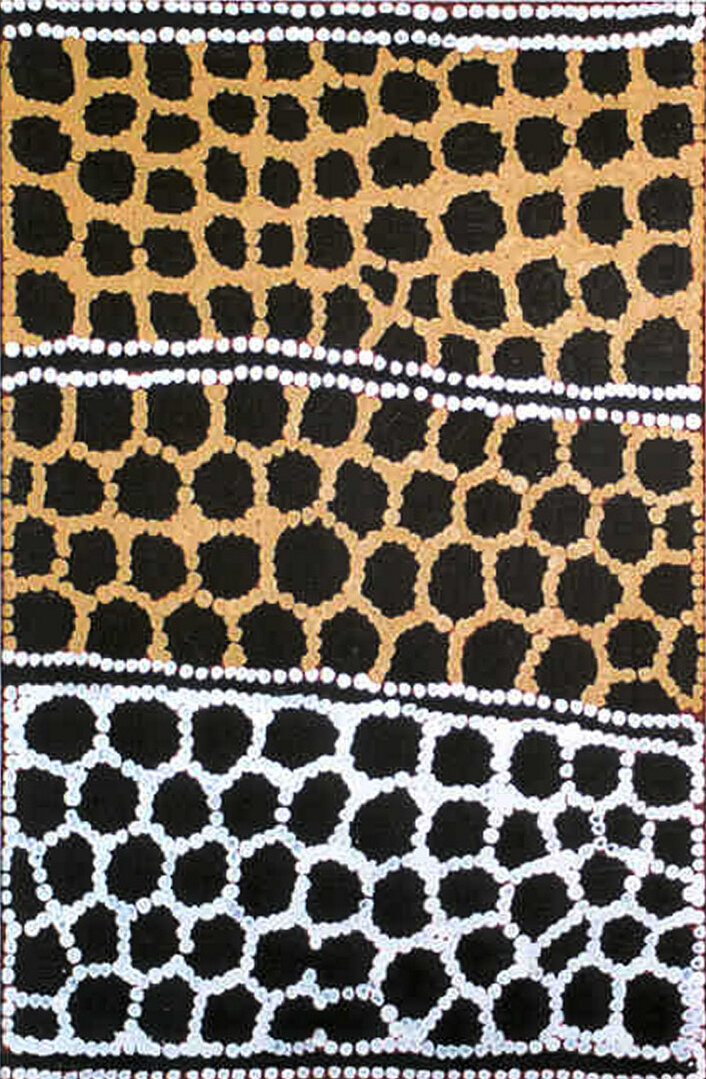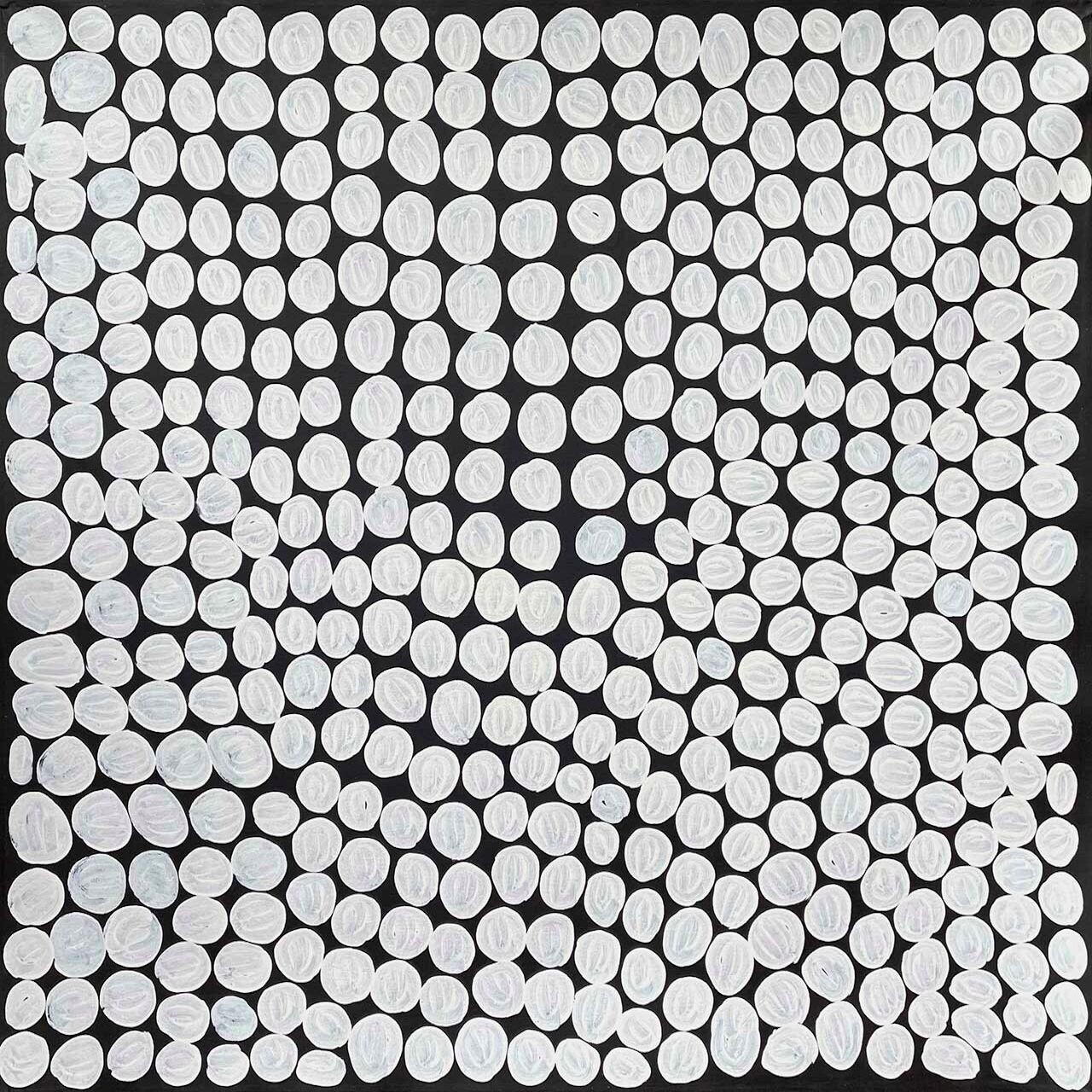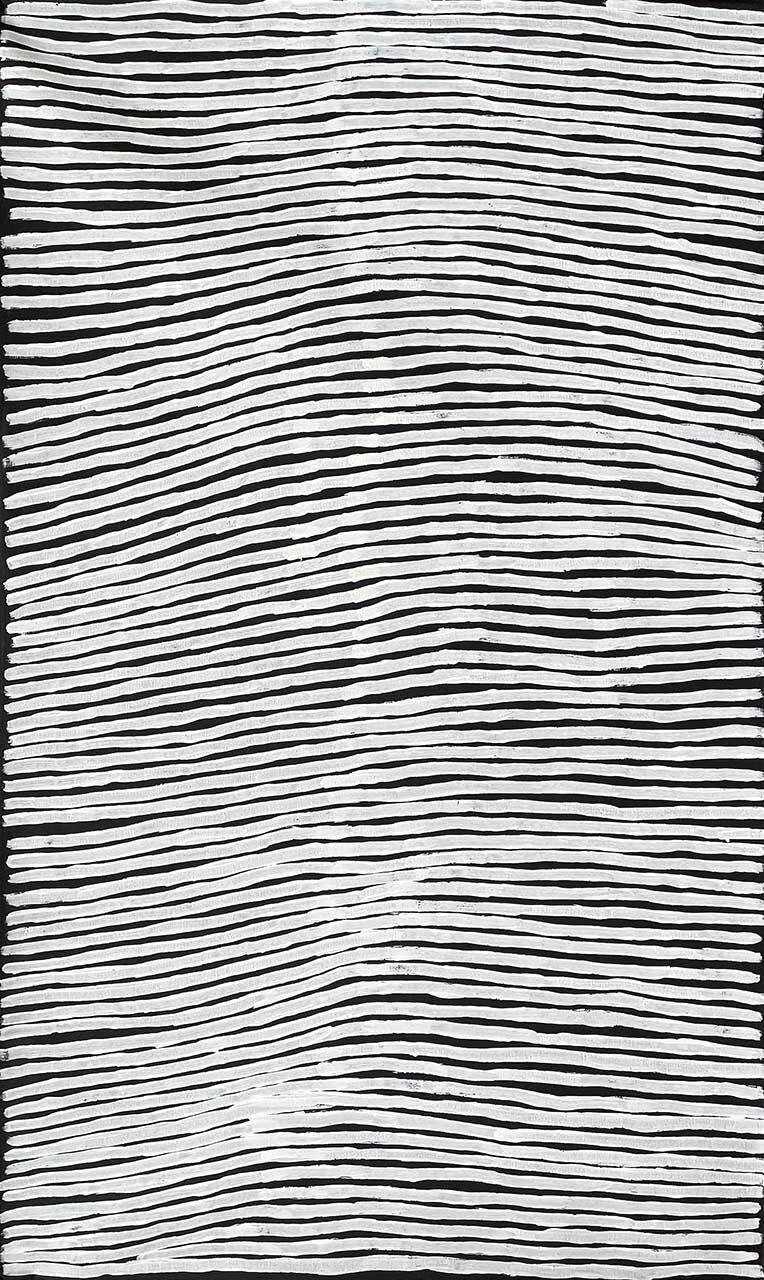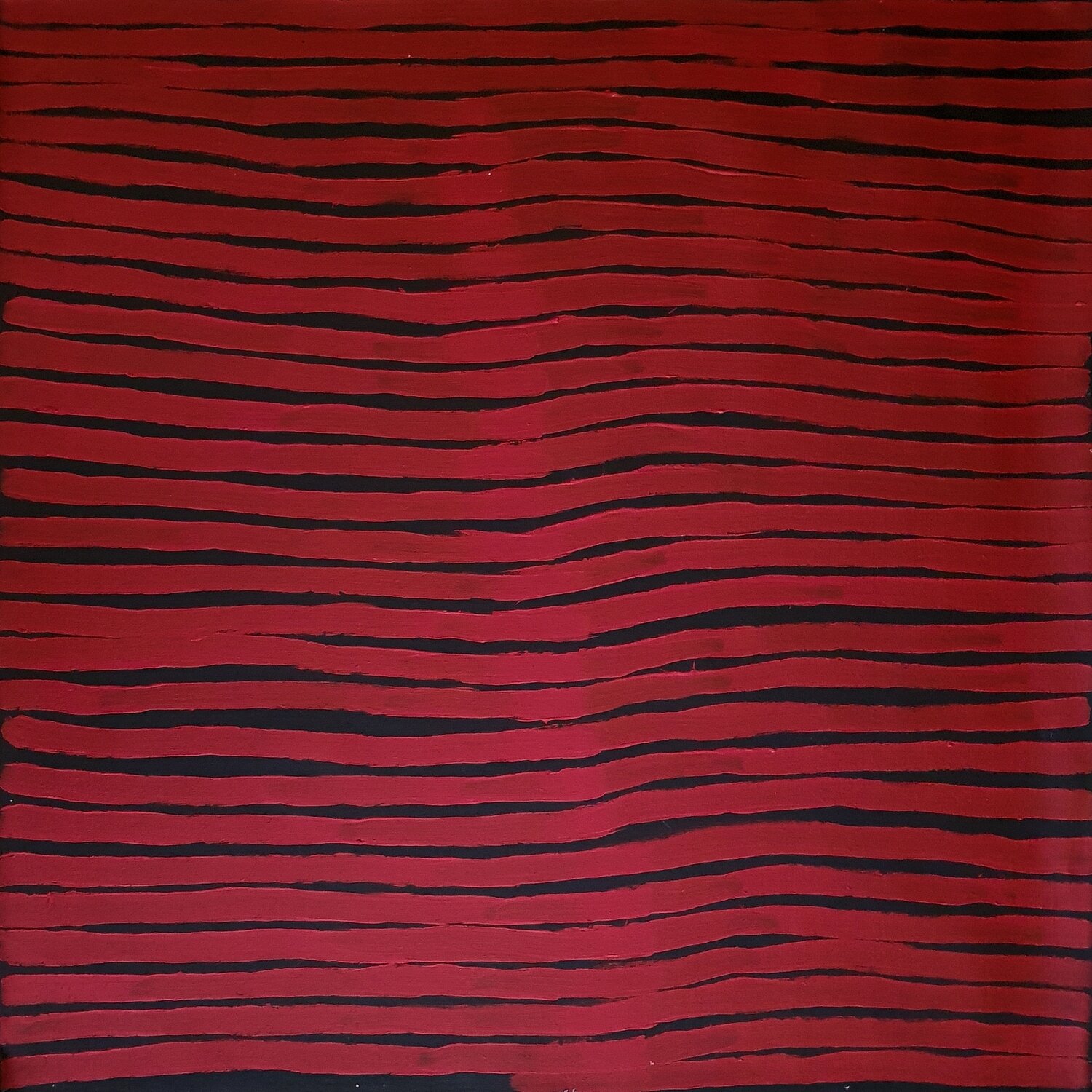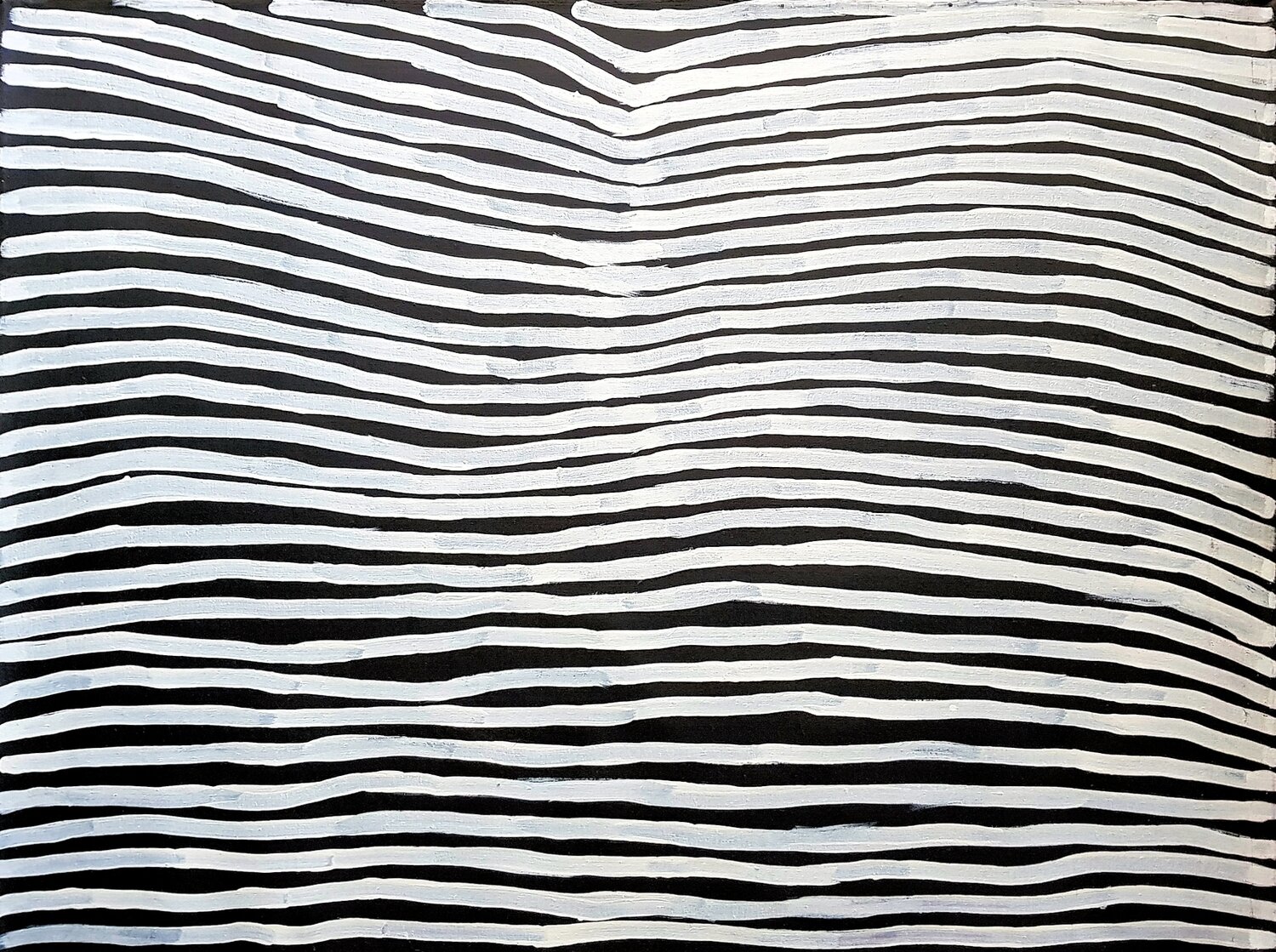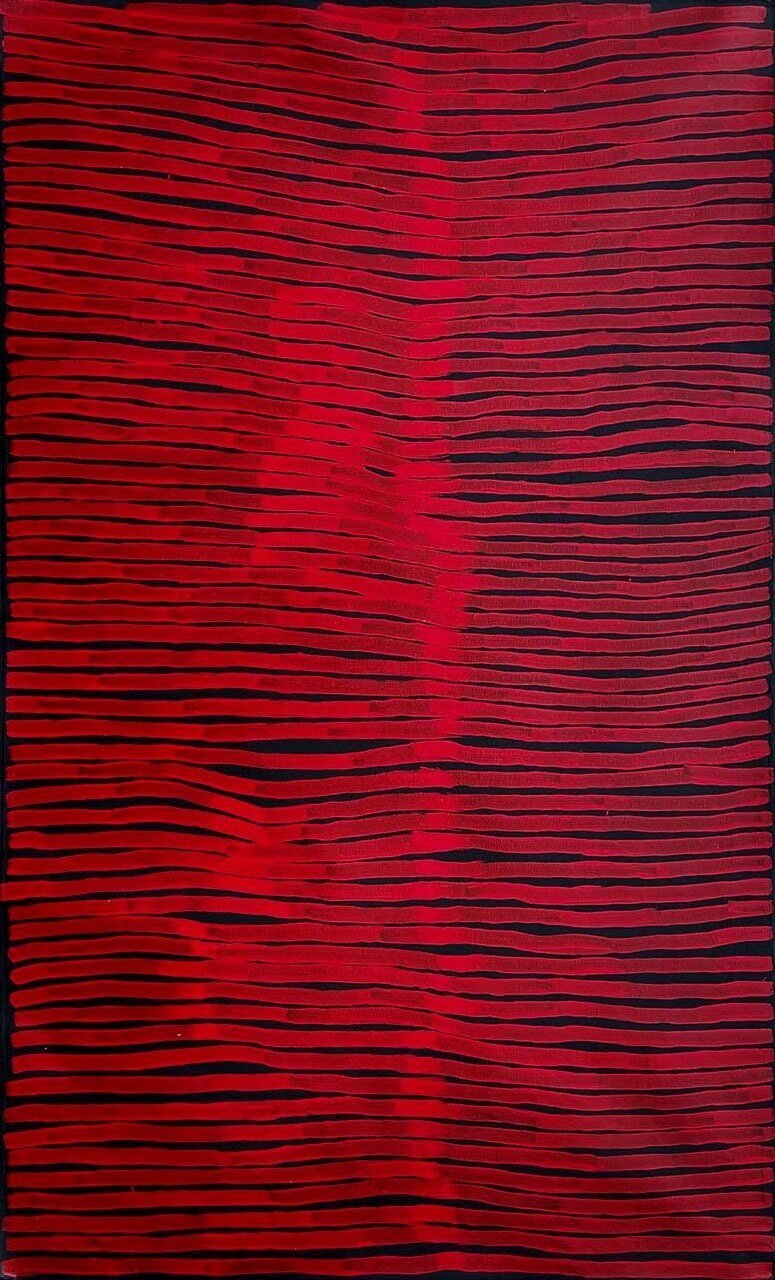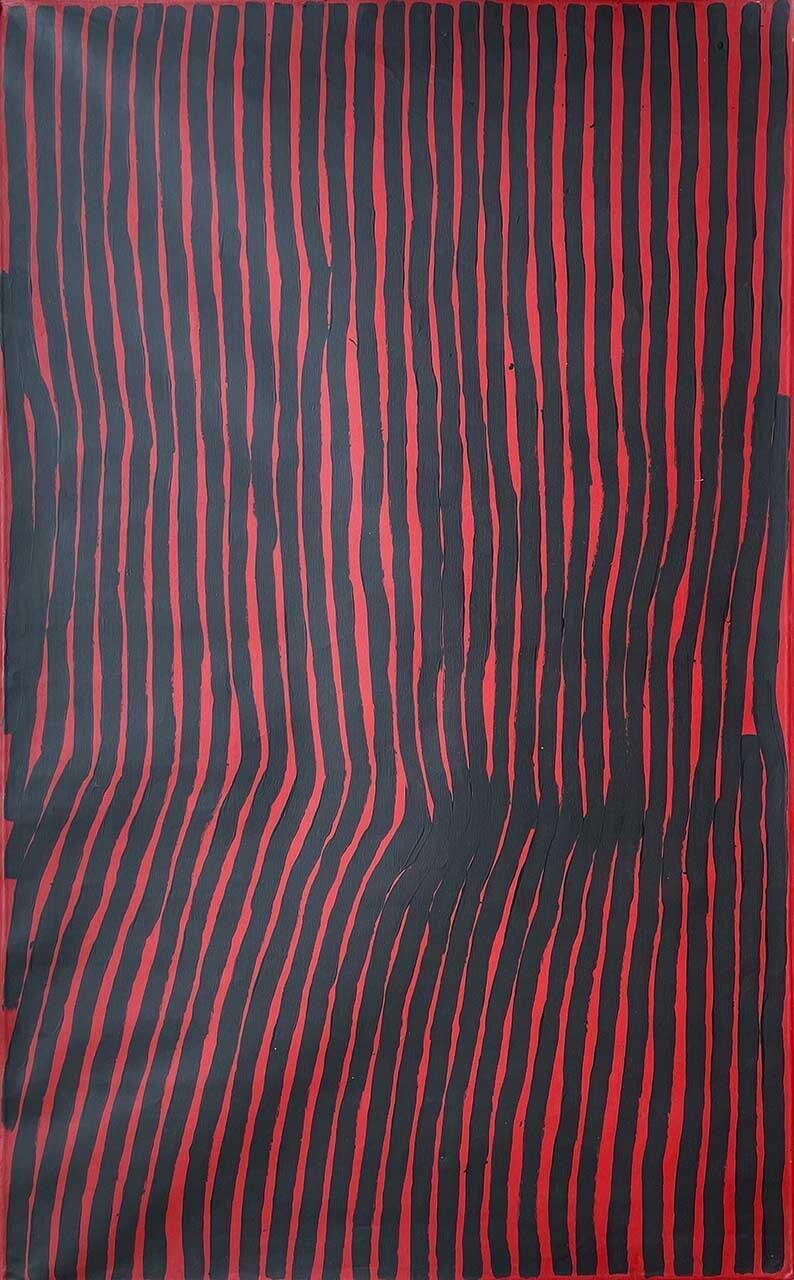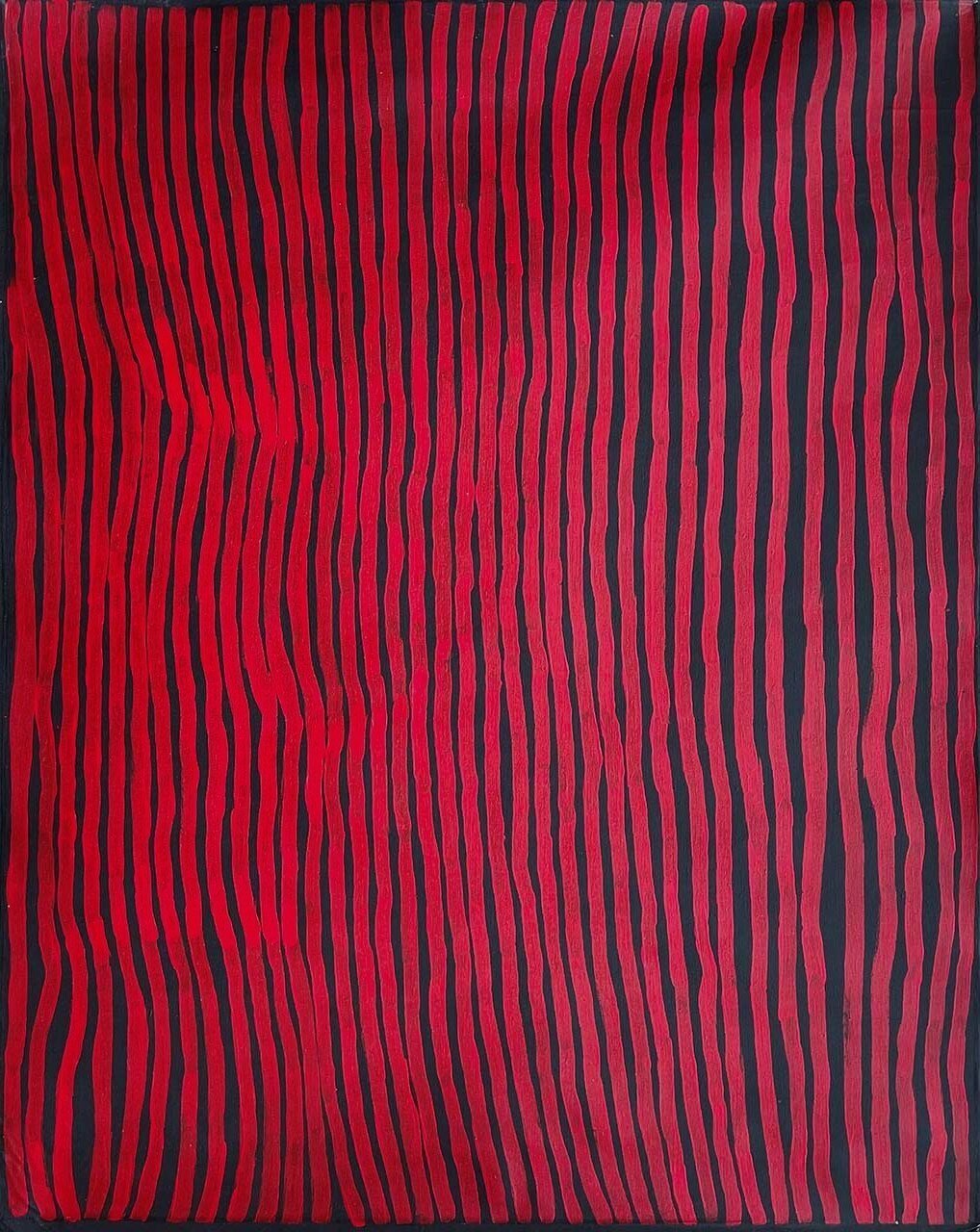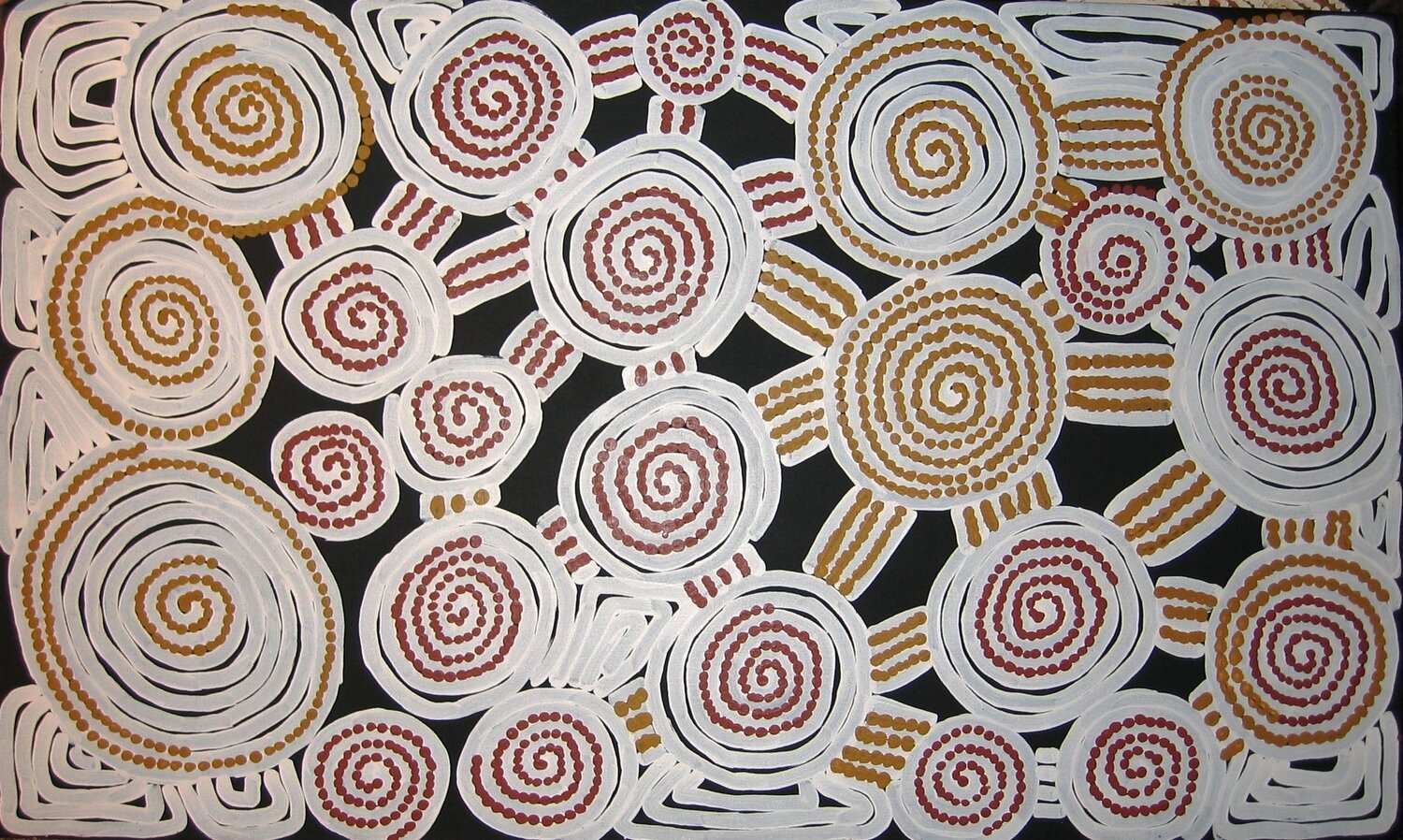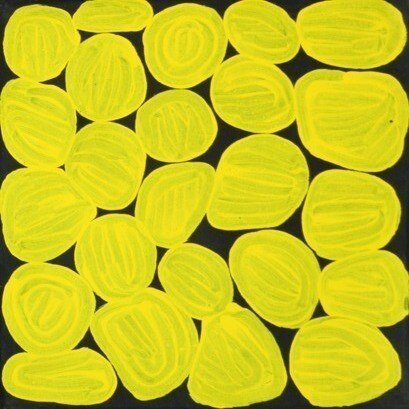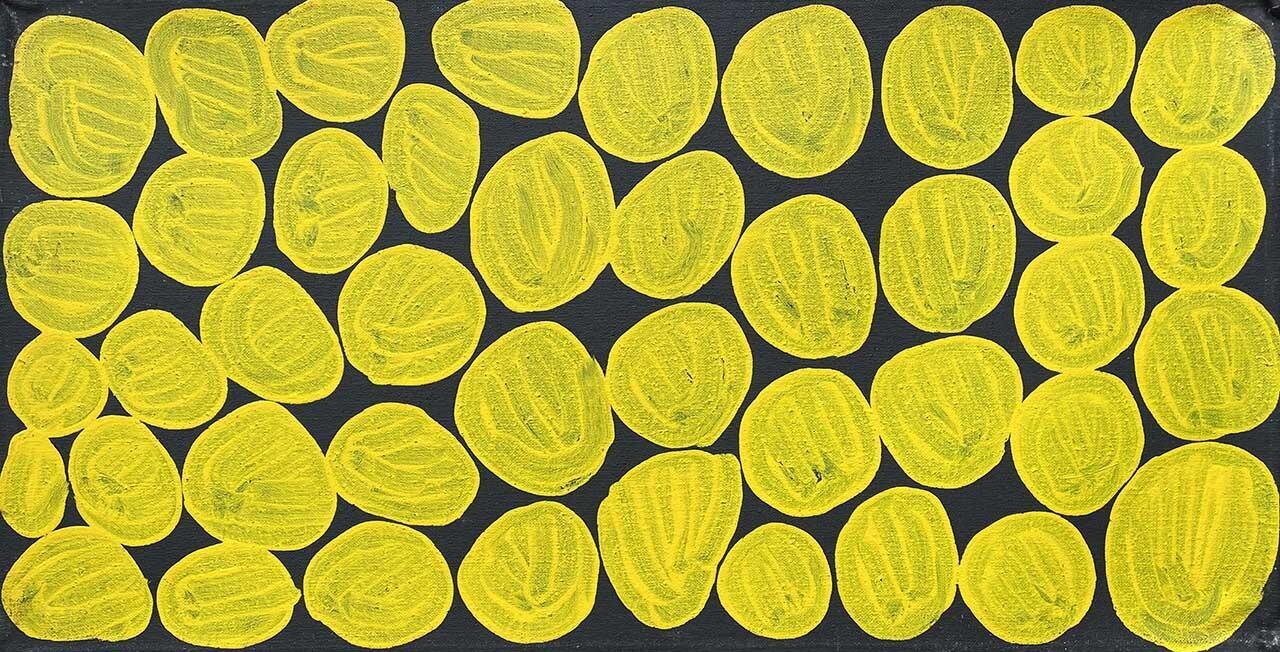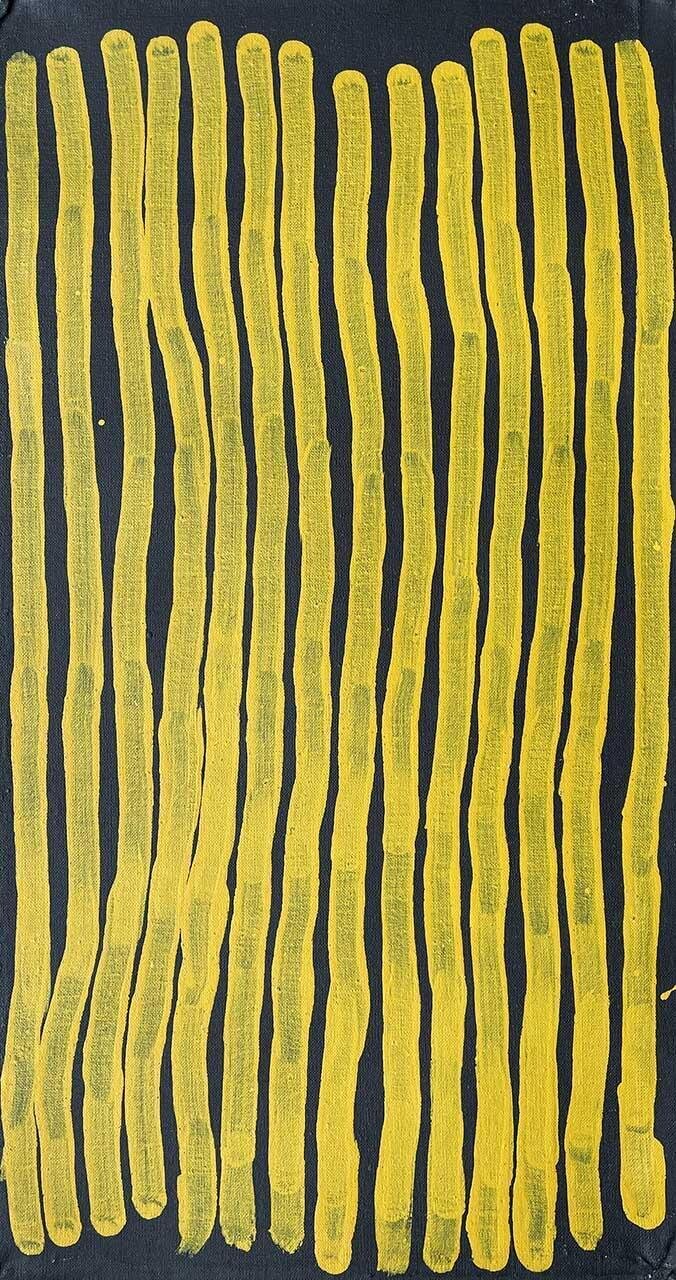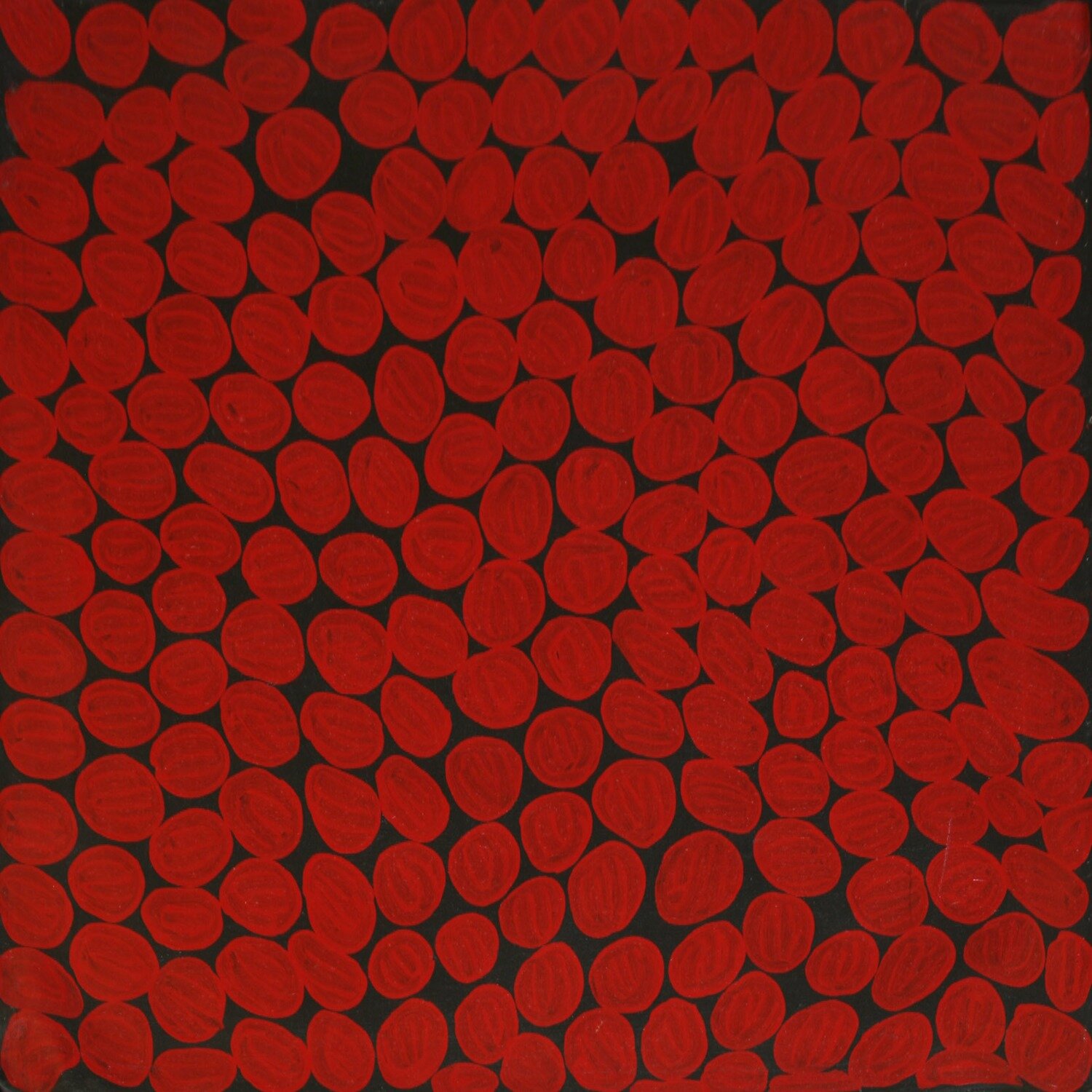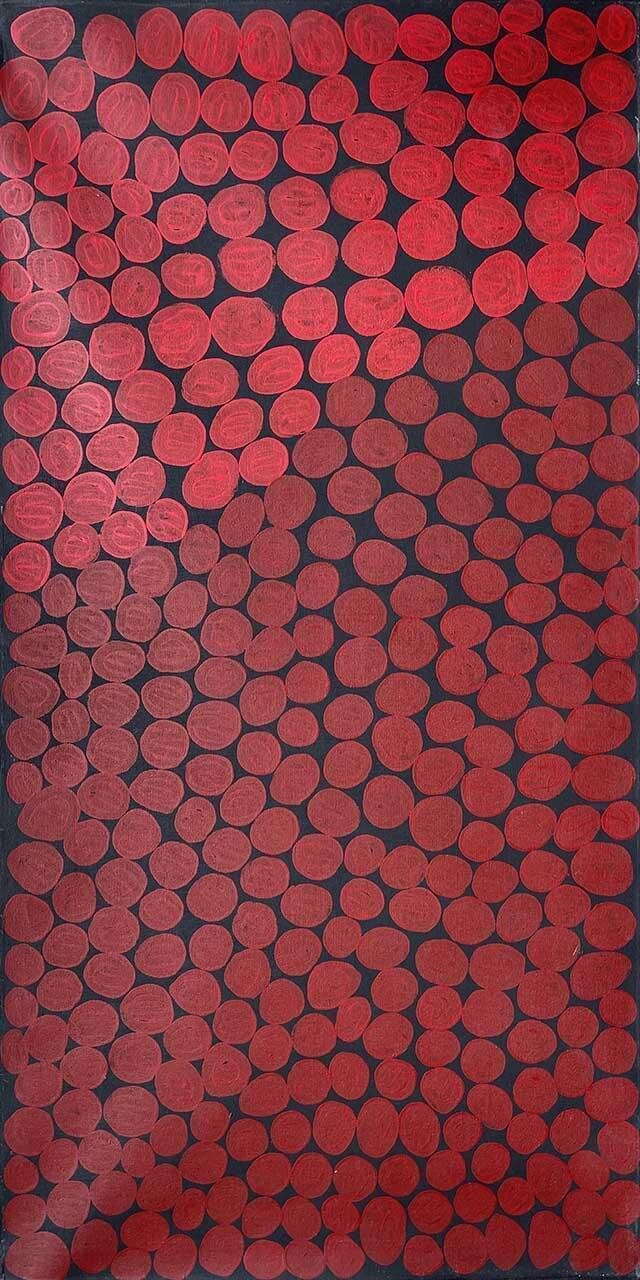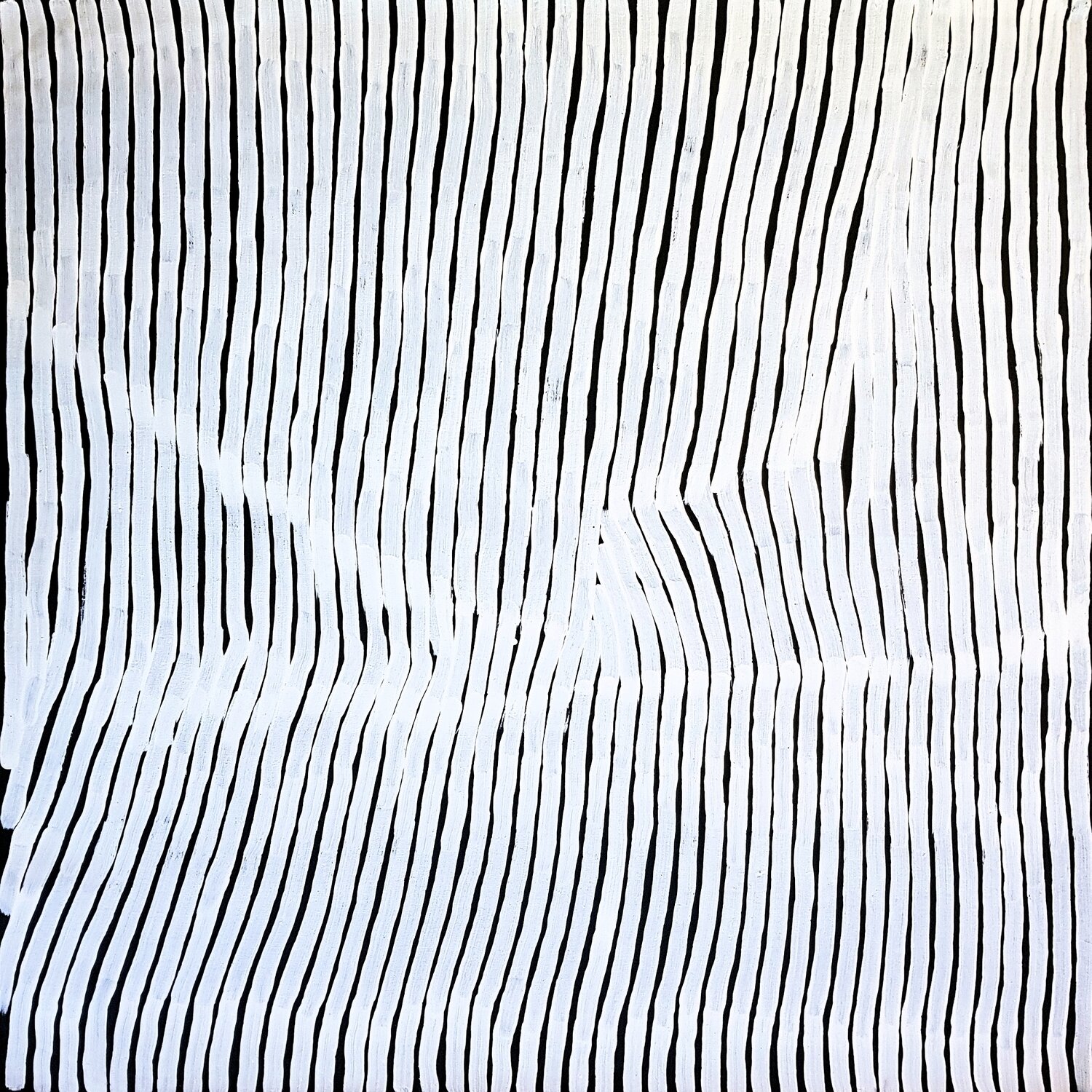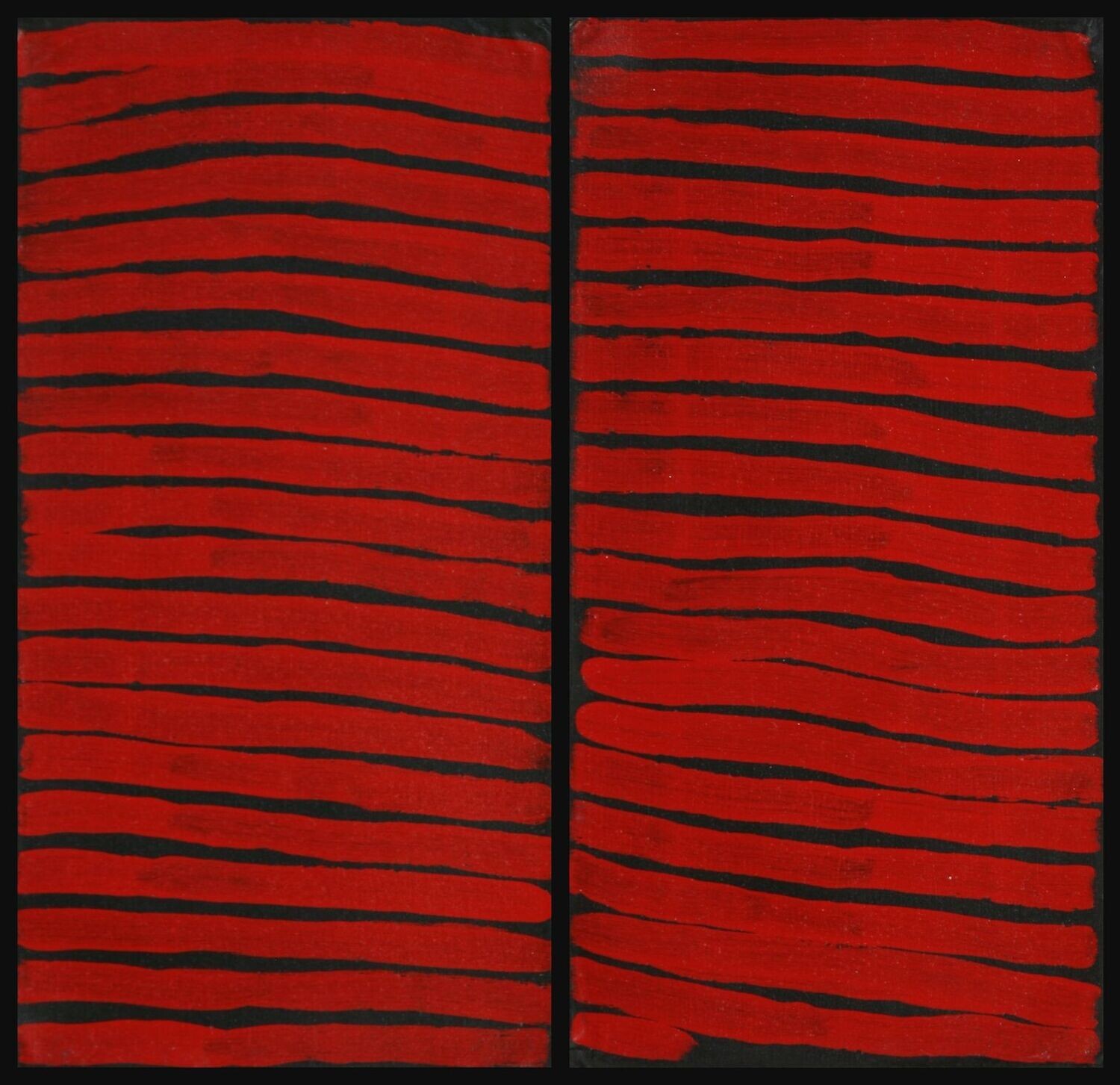Dr George Tjapaltjarri
Dr George paintings possess a wonderful rawness and boldness, conveying his strong, continuous association with his traditional country, ceremonies and the application of body paint designs.
Region: Gibson Desert, WA
DOB: c1930 - 2017
Place of Birth: Kirriwirri, WA
Significant Countries: Karrinwarra, WA, Kilinga (also Kilingya) – Wanampa (west of Jupiter Wells), Kiwirrkurra, Winparku, WA
Language: Pintupi
Communities: Kiwirrkura, Tjukurla, WA
Please bear with us as we continue to bring content from our former website. If you have any questions about this artist and his works, please feel free to contact us.
George Takata Ward Tjapaltjarri, also known as George Tjampu (Ward) Tjapaltjarri, or ‘Dr’ George as he became known was born circa 1930 south-west of Jupiter Well in the Gibson Desert of Western Australia close to the location of present-day Kiwirrkurra. His traditional country includes Karrinwara, west of Kintore, and Kilingya in Wenampa located to the west of Jupiter Well.
The title ‘Dr’ referred to his highly respected work as a community health worker and position as a traditional medicine man of his people. Dr George was one of several Maparn (traditional healers) who worked in association with the Kintore and Tjukurla Medical Clinics. The term Maparn is closely associated with the Kimberley region that stretches across from Western Australia through the Top End. Dr George was a powerful Maparn renowned for his “laying on of hands” and commanded complete respect. In Central Australia, he is described as a Ngangkari, a Pitjantjatjara word that means ‘traditional healer’.
Dr George is of the Pintupi/Luritja language groups. Together with his family ‘Dr’ George first came into contact with white society when he walked out of the desert in 1964. He is an important Pintupi Elder with the responsibility for the initiation of young men into the traditions and ceremonies of their way of life and the esoteric knowledge connected to the ‘Tingari Cycle’. The teaching involved the use of painting horizontal and vertical lines, the ceremonial body paint that was painted on young men during Malliera initiation ceremonies.
Dr George is the younger brother of Papunya Tula artist Tommy Lowry Tjapaltjarri. Dr George first painted a couple of small paintings in Papunya in 1971 and then also painted for Papunya Tula Artists in the mid to late 1970s. He returned to painting in the late 1980s, first for Papunya Tula and then for Gallery Gondwana and occasional other private dealers as an independent artist, achieving recognition for his bold, scaled-up designs.
Since the early 1980’s, Dr George’s talents have been creatively expressed in the field of Contemporary Art. Relying upon traditional narrative and visual language in association with such sacred sites as Ungarla, Nyinmi and Karinwarra, Tjapaltjarri transfers the designs of ephemeral ground sculpture (concentric circles and U-shapes), ceremonial body decoration (parallel lines) and sacred objects onto contemporary media. His paintings which depict the subjects of the Tingari Cycle (journeys of the mythological ancestors) and Snake Dreaming, incorporate both traditional and contemporary palettes both of which are renowned for their wonderful rawness and boldness.
Dr George was a highly respected Ngankari 'Clever Men' and traditional healer for his community. In his paintings, he has left us a legacy of interpretation, straddling twoh worlds old and new medicine with culture and art. You can download Dr George CV here...
For more extensive information about this artist contact us at fineart@gallerygondwana.com.au
-
Rocky Outcrops at Ungarla, 2001 by Dr George Tjapaltjarri 122x122cm Cat 6482DG
SKU 6482DGAU$7,500.00Buy Now -
Malliera Ceremonies, 2000 by Dr George Tjapaltjarri 61x61cm Cat 4828DG
SKU 4828DGAU$1,650.00Buy Now -
Tingari Cycle, 2000 by Dr George Tjapaltjarri 112x152cm Cat 4240DG
SKU 4240DGAU$7,500.00Buy Now -
Malliera Initiation Ceremony (diptych) by Dr George Tjapaltjarri, 2001 41x41cm Cat 6576DG 7098DG
SKU 6576DG 7098DGAU$1,500.00Buy Now -
Rockholes at Ungarla, 1999 by Dr George Tjapaltjarri 198x61cm Cat 3399DG
SKU 3399DGAU$5,500.00Buy Now -
Rockholes at Ungarla, 2000 by Dr George Tjapaltjarri 76x76cm Cat 4299DG
SKU 4299DGAU$2,800.00Buy Now -
Malliera Ceremonies, 1999 by Dr George Tjapaltjarri 122x36cm Cat 3349DG
SKU 3349DGAU$2,200.00Buy Now -
Malliera Initiation Ceremony, 2000 (diptych) by Dr George Tjapaltjarri 61x31cm Cat 5303DG 5304DG
SKU 5303DG 5304DGAU$1,500.00Buy Now -
Snake Ancestor Story, 2000 by Dr George Tjapaltjarri 76x104cm Cat 4298DG
SKU 4298DGAU$4,000.00Buy Now -
Liru Tjuta (Two Snakes), 2001 by Dr George Tjapaltjarri 66x122cm Cat 11066DG
SKU 11066DGAU$4,200.00Buy Now -
Tingari Cycle, 2002 by Dr George Tjapaltjarri 46x46cm Cat 7191DG
SKU 7191DGAU$850.00Buy Now -
Rocky Outcrops at Ungarla, 2001 by Dr George Tjapaltjarri 91x61cm Cat 4880DG
SKU 4880DGAU$2,800.00Buy Now -
Rockholes at Ungarla, 2001 by Dr George Tjapaltjarri 122x130cm Cat 6416DG
SKU 6416DGAU$7,500.00Buy Now -
Malliera Ceremonies, 2001 by Dr George Tjapaltjarri 122x91cm Cat 6444DG
SKU 6444DGAU$5,500.00Buy Now -
Malliera Ceremonies, 2001 by Dr George Tjapaltjarri 152x91cm Cat 6242DG
SKU 6242DGAU$7,500.00Buy Now -
Malliera Ceremonies, 2000 by Dr George Tjapaltjarri 122x122cm Cat 5287DG
SKU 5287DGAU$7,500.00Buy Now -
Malliera Ceremonies, 2000 by Dr George Tjapaltjarri 91x91cm Cat 6081DG
SKU 6081DGAU$4,500.00Buy Now -
Malliera Ceremonies, 2000 by Dr George Tjapaltjarri 91x122cm Cat 4197DG
SKU 4197DGAU$5,500.00Buy Now -
Malliera Ceremonies, 2000 by Dr George Tjapaltjarri 122x198cm Cat 5286DG
SKU 5286DGAU$12,500.00Buy Now -
Malliera Ceremonies, 2002 by Dr George Tjapaltjarri 198x122cm Cat 7133DG
SKU 7133DGAU$12,500.00Buy Now -
Malliera Ceremonies, 2000 by Dr George Tjapaltjarri 152x122cm Cat 4196DG
SKU 4196DGAU$9,500.00Buy Now -
Tingari Cycle, 2001 by Dr George Tjapaltjarri 91x152cm Cat 6720DG
SKU 6720DGAU$7,500.00Buy Now -
Rocky Outcrops at Ungarla, 2002 by Dr George Tjapaltjarri 41x41cm Cat 6755DG
SKU 6755DGAU$750.00Buy Now -
Malliera Ceremonies, 2001 by Dr George Tjapaltjarri 152x51cm Cat 6427DG
SKU 6427DGAU$4,000.00Buy Now -
Rockholes at Ungarla, 2001 by Dr George Tjapaltjarri 61x31cm Cat 6483DG
SKU 6483DGAU$750.00Buy Now -
Malliera Initiation Ceremony, 2001 by Dr George Tjapaltjarri 31x61cm Cat 5306DG
SKU 5306DGAU$750.00Buy Now -
Malliera Ceremonies, 2001 by Dr George Tjapaltjarri 91x91cm Cat 6421DG
SKU 6421DGAU$4,500.00Buy Now -
Rocky Outcrops at Ungarla, 2000 by Dr George Tjapaltjarri 91x91cm Cat 6058DG
SKU 6058DGAU$4,500.00Buy Now -
Rockholes at Ungarla, 2001 by Dr George Tjapaltjarri 149x75cm Cat 6459DG
SKU 6459DGAU$5,500.00Buy Now -
Malliera Ceremonies, 2002 by Dr George Tjapaltjarri 122x152cm Cat 4404DG
SKU 4404DGAU$7,500.00Buy Now -
Malliera Ceremonies, 2000 by Dr George Tjapaltjarri 30x60cm Cat 6042DG
SKU 6042DGAU$750.00Buy Now -
Malliera Ceremonies, 2001 by Dr George Tjapaltjarri 122x122cm Cat 6428DG
SKU 6428DGAU$7,500.00Buy Now -
Malliera Ceremonies, 2000 (part of diptych) by Dr George Tjapaltjarri 61x31cm Cat 6015aDG 6015bDG
SKU 6015aDG 6015bDGAU$1,500.00Buy Now
GALLERY GONDWANA
ABN: 75 009 652 046
All prices displayed in AUD, GST included.
Gallery Gondwana acknowledges the First Peoples of this land and recognises their continuous connection to culture, community and Country.
CONTACT US
+61 417 75 74 75
+61 417 27 44 31
info@gallerygondwana.com.au
PO Box 3770, Alice Springs NT 0871 Australia
Vatu Sanctuary
Saturate yourself and be inspired by the power of Aboriginal art in a living gallery environment.

All Rights Reserved | Gallery Gondwana

